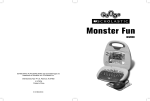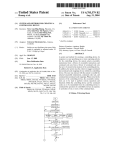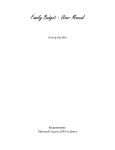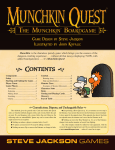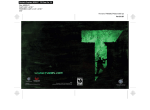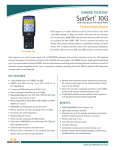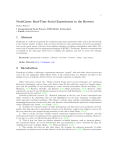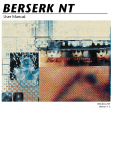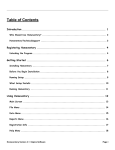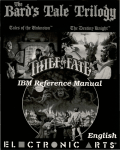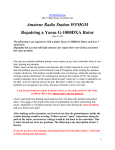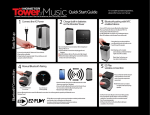Download Munchkins
Transcript
Munchkins Weston Birnbaum Whitney Magnuson Virginia Pierson TABLE OF CONTENTS Setup/Intro ..........................................pg 1 Managing the Cards..........................pg 1 Character Creation.............................pg 1 Starting and Finishing the game......pg 1 Turn Phases........................................pg 1 Combat................................................pg 2 Asking for Help...................................pg 3 Running away.....................................pg 3 Death...................................................pg 3 Treasure..............................................pg 4 Character Stats...................................pg 4 Items....................................................pg 4 Talking with Other Players..............pg 5 Game Interface.................................. .pg 5 SETUP/INTRO This user manual is for people who would like to play the electronic version of Munchkins. Munchkins is a dungeon style game in which 3 to 6 people can play. It consists of 2 different deck of cards (a Door deck and a Treasure deck), a sixsided die, and the following rules. Each player will start with two cards from each deck. MANAGING THE CARDS There will be two separate discard piles for the two different decks. If a deck runs out, the computer will automatically take the discard pile and shuffle them. If there are no discards when a deck runs out, players will not be able to choose any cards from that deck. Cards in play are the cards that are in front of the player on the screen, showing your Race and Class (this will be explained later) and any items you are carrying. Some item cards have permanent abilities and will stay on the field after you play them, unless you choose to remove them. Cards in your hand are cards that are not in play and are not visible to the other players. You may choose to play these cards at any time, however these cards do not help you when not in play and can only be taken away by curse cards that affect your hand. At the end of a turn, you may not have more than five cards in your hand. Cards can be played at different, but specified times (again, this will be further explained later in the manual). After a card is played, it must be discarded to the appropriate discard pile. CHARACTER CREATION Every player starts as a level 1 human with no class, race or special items. Look at the first four cards you are dealt at the beginning of the game. If you have any Race or Class cards, you may play one of each type. A Race card is a card that changes This is done by placing it face up in front of you. If you have any usable items, you can also play these by putting them face up in front of you. STARTING AND FINISHING THE GAME To determine who goes first, a die will be rolled, whoever gets the highest will go first. Play proceeds in turn by going clockwise around the playing space. You win the game by reaching level 10. In order to do this, you must kill a monster, unless a card specifically allows you to win by other means. TURN PHASES At the start of your turn, you may play cards, trade items with other players, and sell items for levels. After this you may move to the first part of your turn. 1)A draw card will be taken from the Door deck and will be turned face up. If it happens to be a monster, you must fight it (see combat section). Combat must be completely resolved before going on. If you kill it, the player will go up one level, unless otherwise specified on the monster card, and take the appropriate number of Treasure cards listed on the Monster card from the Treasure deck. If the face up card is a curse, it applies to the player immediately and is then discarded to the discard pile. If the card is any other card, the player will have the choice of putting in their hand or playing it immediately. 2)If the player did not come in contact with a monster, that player has a choice of playing a monster from their hand and fighting it. Or: 3) The player can draw a second card from the Door deck, face down, and it will be placed in the players hand. If you HAD met a monster but chose to run away, then you cannot loot the room. 4)This is the last phase of a players turn and it is the step of ditching cards if you possess more than five cards. In order to get rid of cards, a player can either play the card, give the excess to the player with the lowers level, or simply discard it. If players are tied, divide up the cards evenly. If the player is the lowest level, then the extra cards will just be discarded. After this phase, it becomes the next players turn. COMBAT When a player encounters a monster, their combat strengths are compared. Combat strength for the player is calculated by the total number of levels plus all modifiers given by items and other cards that the player possesses. The monster’s combat strength is it’s level at the top of the card, plus any items that another player may choose to play against the current player. If the monster’s combat strength is equal to the players or is greater, the player loses the combat and must attempt to run away (explained below). If the players combat strength totals more than the monster’s, the player kills it and goes up a level. That player then also gets to choose a number of Treasures shown on the monster card. Sometimes a card, or a certain Class or Race power will let the player get rid of the monster without having to actually kill it. This is still consider “winning”, but that player does not get a level and may only receive the treasure. Some monster cards also have special powers that affect combat, a bonus against a certain Race or Class is an example of this. Some cards can be played during combat in which they are called oneshot items. An example of this is Potions. These type of cards must be discarded after combat, whether or not the player won or lost. While a player is in combat, they cannot sell, steal, equip, unequip, or trade any times from their hand, except for the oneshot cards of course. Once a monster card is exposed, the player must resolve the fight with their equipment as it stands. When the fight is over, the monster card is discarded along with any enhancers and oneshot items played and the player draws treasure (if they won). But after you fight the monster, another player can play a hostile card on you, or use some special power. Some cards allow the other players to send other monsters to join the fight against the current player. That player must defeat their combined combat strengths. Any special abilities like forcing the player to fight with only their level applies for the entire fight. If the player has the right cards, they have the possibility of eliminating one monster from the combat and fight the other(s) normally. The only thing the player cannot do in this situation is fight one of the monsters and run from the others. If a player eliminates one monster with their Race or Class power, but then runs from the rest, they do not get any treasure. ASKING FOR HELP If a player cannot win a combat on his own, that player may ask for help from the other players. The other players have the right to refuse, but only players can help adding their combat strength to theirs. Anyone can play cards to affect your combat though. A player can bribe someone to help. They can offer any of the items they are carrying or any number of the Treasure cards. The special abilities or vulnerabilities of the monster also apply to the players helper and vice versa. For example, if a Warrior helps another player, that player will win if the combined total ties that of the monster, and he can Berserk and discard cards to add to his combat strength. If someone successfully helps the player, the monster is slain, so the player discards it, and draws treasure, and then follows any special instructions on the monster card. Because the monster was slain, the player goes up a level, but the one who helps does not, unless he is an Elf. The player draws the Treasure cards, even if it was the helper’s special ability that killed the monster. RUNNING AWAY If a player cannot defeat a monster with or without help they must run away. If a player runs away they do not get a level or any treasure. The player does not necessarily escape unharmed either. A die must be rolled the player only escapes if the roll is a five or better. Some items will make it easier or harder for a player to run away. Some monster though are fast, and give a penalty for the player rolling. If the player escapes the monster, then the monster is discarded and the player receives no treasure. Some monsters will still hurt the player even if they run away. If the monster catches a player when they are attempting to run away, it will do “bad stuff” to that player, which is described on the card. This may vary from losing an item to losing one or more levels, even to death. When a player is receiving help and the combined strength cannot kill the monster, then they both must flee. Each player will roll separately and the monster does have the option of catching both players. If a player is running away from multiple monsters, then they must roll separately for each monster to attempt to escape all monsters involved. DEATH If a player die, that player loses all of their stuff. The player keeps their Class, Race, and level, also any curses that were affecting the player when they died. The new character will look just like the players old one. When a player dies, their body is looted. That player will lay their hand beside the cards they had in play and the player who has the highest level will pick a card. Then the next highest level and so on will choose one card. When the corpse runs out of cards, then looting the corpse is over. Every player gets one card from the dead player and any extra cards are discarded into the appropriate pile. Dead players cannot receive any cards for any reason and they cannot level up. The dead player gets a new character the moment the next player begins their turn, but the new character starts with no cards. Upon the recently resurrected players next turn, they draw four cards from each deck, facedown, and play any legal Race, Class, or Item cards they want to. It is exactly like how the player stated the game. The turn then continues normally. TREASURE When a player defeats a monster by killing it or using a card to eliminate it, that player receives Treasure. Each monster has a Treasure number (as you can see in the lower right of the monster Little Foot). Draw that many Treasure cards, in this example we would take two Treasure cards. If the player kills the monster alone, then the Treasure cards are picked facedown, but if the player received help to defeat the monster, then the cards a picked faceup for the whole game to say what they have received and depending on the deal that the player made to receive help, some of those treasure cards may go to the helping player. Treasure cards can be played the moment they are received. CHARACTER STATS Each character is a essentially a collection of weapons, armor, and magic items, with three stats: Level, Race, and Class. Level describes how buff the player is. When cards refer to the players Level, they mean this number. As stated earlier, everyone starts as a human for Race. But there are other races: Elves, Dwarves, and Halflings. Every race except Humans give some sort of special ability and some disadvantages. The player gains the ability of that Race the moment that card is played in front of them and the ability is lost the moment the card is discarded. A player may discard their Race card at any time, even in combat. When this is done, that player becomes a human again, unless they immediately play another race card.. A player cannot belong to more than one race at a time. Lastly, are the Class cards, these include Warriors, Wizards, Thieves, and Clerics. If the player has no Class card in front of them then they have no class. Just like the Races, each Class has a special ability and disadvantage, which are shown on the card. Again like the Race cards, the player gains the Class ability the moment it comes into play and is lost as soon as it is discarded. Same rule for abilities charged by discarding applies. The player can discard a Class card at any time, even in combat. When a player discards their Class card, they are classless until they play another Class card. A player cannot have more than one Class. ITEMS An item consists of a name, a power, a size, and a value in Gold Pieces. An item card does not count until it has been played. Once an item is played it is considered to be carried. A player can carry any number of small items, but only one big one. If an item is not marked big, it is considered to be small. Lets use the card on the left as an example. It has a name, which is Portable Hole. And an effect which can be read on the card. And in the lower right is the amount of Gold Pieces this item is worth by selling. Because it is not labeled as a big item, it can assumed that it is a small item and a player could equip it without a problem. If something lets a player have more than one big item and you lose that ability, then that player must either correct the problem immediately or get rid of all but one big item. As long as it is a players turn and they are not in combat, they can sell any excess big items. Otherwise, if it is not their turn then the remaining excess big items must be discarded. Any player can carry any item, but some items have restrictions. An example is a item called the Mace of Sharpness which can only be wielded by a Cleric. Its bonus only counts for a player who is, at that moment, a Cleric. As a character, you can wield weapons and wear armor, but a player can only have on one headgear item, one suit of armor, one pair of footgear, and two “1 Hands” items or one “2 Hands” item. A player may not change their used or carried items during a combat or while running away. A player may discard to power certain Class and Race abilities. A curse may force a player to get rid of some items. Trading is an important aspect. A player can trade items but not other cards to other players. In order for an item to be traded, it has to be on the playing space and not from a players hand. Trading can occur at any time except for when the player is in combat. If a player trades an item, it must go into play and it cannot be sold or discarded until it is that players turn. Players can also trade items to other players as a bribe. For example, a player may give another player an item if they do not help someone in combat. An important part of the game is selling items for levels. During a players turn, they can discard items worth at least 1000 gold pieces and immediately go up one level. If a player discards more than 1000 gold pieces worth, they do not get the change, but obviously, if the player discards 2000 gold pieces worth, they can go up two levels. A player can sell items from both their hand and what they have equipped. The only restriction is a player cannot sell items to reach level 10. TALKING WITH OTHER PLAYERS Within the game window, players will be allowed to talk to each other via an IM chat box. This allows players to form alliances or to make bribes that are not strictly item to item, allowing for easier communication and a more interesting game. A player merely has to type their message in and hit enter or click the send button for this to work. NOTE: It will not be private and all players will be able to see what message you send. GAME INTERFACE When the user opens the game, they will first be brought to a menu screen with the options of Start, About, Options, and Exit. If the user selects start, they will be prompt for how many people are playing and it will then proceed to the game layout. If the user clicks about, it will give a small description of the makers and the game. When options is selected, the user will have the choice of slightly changing some rules of play. And the exit screen will close out of the application window. The game interface will include space for all the cards, playing field, players stats, a chat window, and a menu window. This game will be played by the connection of computers, so each player will have their hand at the bottom of the window. The cards in the player’s hand will be displayed by having a small portion be shown at the very bottom. Cards that are in play, i.e. the race and class cards will be fully shown and face up on the play field. A player clicks a card and will receive a drop down menu of options to do. Examine, which would then bring up the card in a larger format so the player can read what it does, see how many gold pieces it’s worth, etc... The menu will also have the options of discarding the card, trading it, playing it, and selling it. Next, we have the game space in the middle of the screen. This is where battles will take place along with trading. There will also be a small window for each of the other players stat that would hold their level, class, race, and combat strength. The IM window will be to the right of the screen in the lower right corner. There will also be a menu box to the left of the players cards that give the player options to do outside of his turn. Such as playing cards that will affect other players combat outcome.








